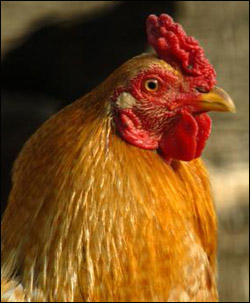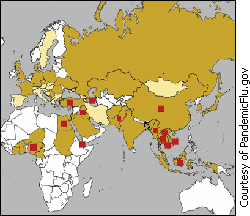
|
|
When repression is a good thing A team of biochemistry professors and researchers at McGill University experimented with translational repressor genes, which act like stenographers in the copying of DNA, hoping to create a new antiviral tool.
"It was a knockout," says Dr. Nahum Sonenberg, professor of biochemistry at McGill and co-author of the study published in February's issue of Nature. "We deleted the virus completely from the mouse [which we had infected for testing]. It is now resistant to infection." Viruses, including avian flu, replicate themselves by hijacking the "stenographers" of the cells they invade. When the cell tries to manufacture proteins, genetic information from the virus takes the place of the material to be transcribed, producing more viruses. "We could not have expected this result," says Sonenberg, "but the general idea was rational. We said, 'let's see how we can affect virus replication.'" The idea of modifying and affecting translational repressors is nothing new; it is used to study genes of all varieties. But the technique had never before been applied to viral infections. And from the researchers' perspective, it is a sign of significant progress. "Let's say there is an avian flu epidemic," says Sonenberg. "Then you can treat uninfected people as well, to raise their level of interferon [a protein produced by the immune system to fight off foreign agents such as viruses] so they will be protected. It also works as a preventative treatment." Prevention through pH Meanwhile, at Harvard University, a team of researchers has finally grasped the mechanism of the drug amantadine, commercially the most heavily-used vaccine against Influenzavirus A. "We didn't know how [amantadine] work
ed -- those drugs were found empirically, through blind testing," says Dr. James Chou, assistant professor of biological chemistry and molecular pharmacology at Harvard. Influenza has become highly resistant to amantadine, which is now effective in fewer than 10 per cent of cases. Tamiflu, another, even bigger, drug in the market, may soon be equally useless, because new strains resistant to Tamiflu have recently been discovered. Viruses require a low pH in order to unpackage their genetic information for the takeover of a cell. Crucial to this process is a cellular component called an M2 channel, which acts as a gatekeeper, detecting a lower pH outside the virus and opening up, allowing protons into the virus which acidify it, triggering its attack upon the host cell. By blocking the function of this channel, it is possible to prevent the virus from replicating. Chou says this knowledge may prove to be crucial to the creation of successful future vaccines against the virus. "Now that we understand how [amantadine] works, we can use the same concept to create something the virus cannot evade," he says. Another strength of the vaccine and this particular approach to fighting the virus is that it focuses on the M2 viral protein, which does not change from strain to strain, as opposed to the proteins targeted by traditional flu vaccines, which undergo mutations, making them very difficult to target. Vaccines which focus on these proteins can be compared to police officers trying to use fingerprinting to catch a serial killer with the ability to shape-shift; by the time the officers have lifted a print from a crime scene, the killer may have changed form and have completely different fingerprints. Synergy Asked about the concurrent research of Sonenberg and his team at McGill, Chou says, "The important thing is that we don't just rely on one drug to target one component of the virus, but rather on multiple drugs targeting many components of the virus. The end goal is to present as strong an evolutionary pressure on the virus as we can, so that the virus will just give up. All the drugs will contribute, and combined use of the right drugs will succeed in fighting the virus."
The big picture More overt threats to human health such as cancer and HIV/AIDS claim millions of lives each year. But although avian flu has amassed a comparatively meager death toll of 234 since first infecting human beings in 1997, at least 17 governments around the world are pouring billions of dollars into research and preparation for a possible pandemic. And the virus's stunning 62 per cent mortality rate in humans infected with avian flu appears to give them good cause. Avian flu has also taken a powerful economic toll. Tens of millions of birds have died from the virus, and hundreds of millions more have been culled to prevent it from spreading. Meanwhile, a completed vaccine is years away from full testing, approval, and distribution. |
|
|

